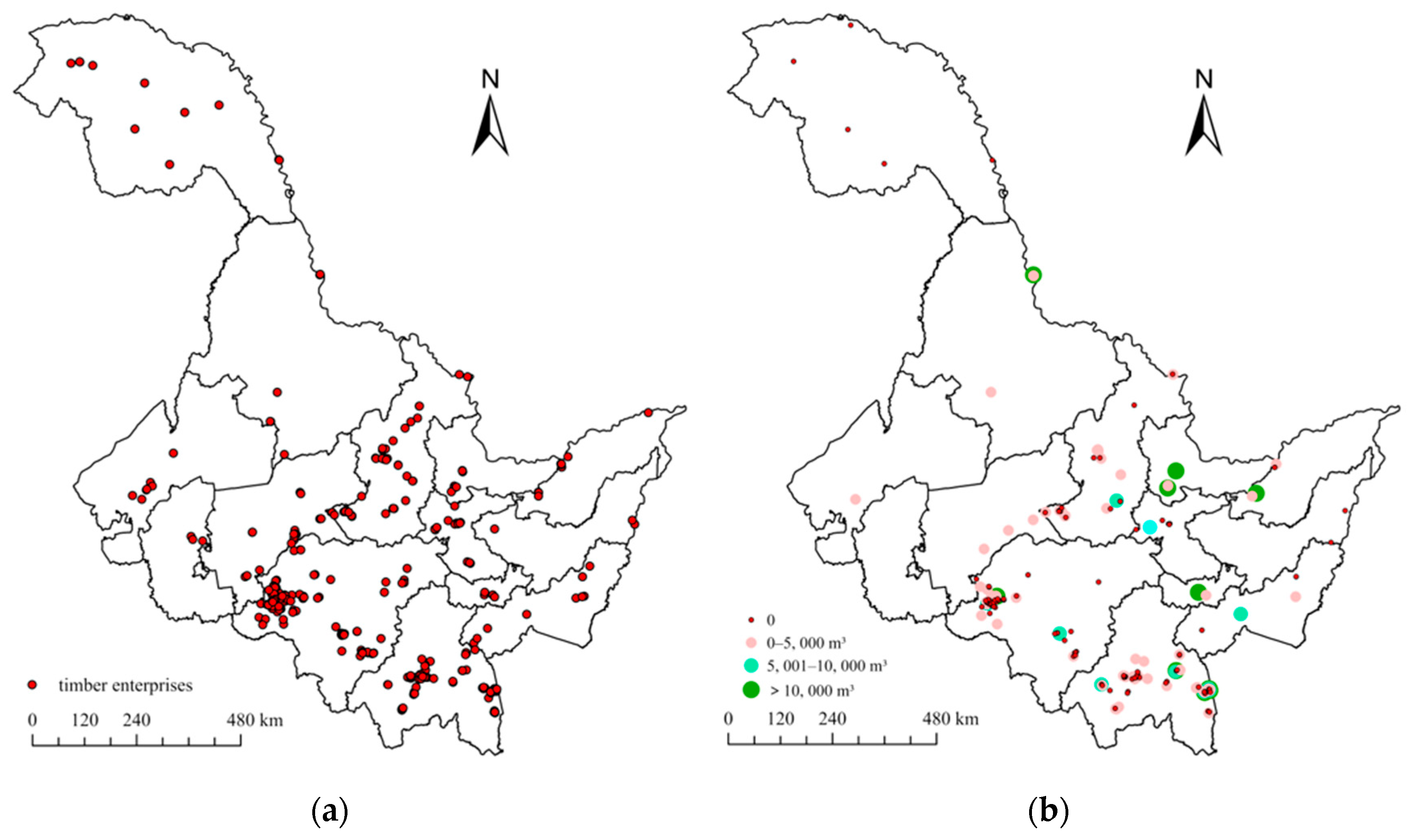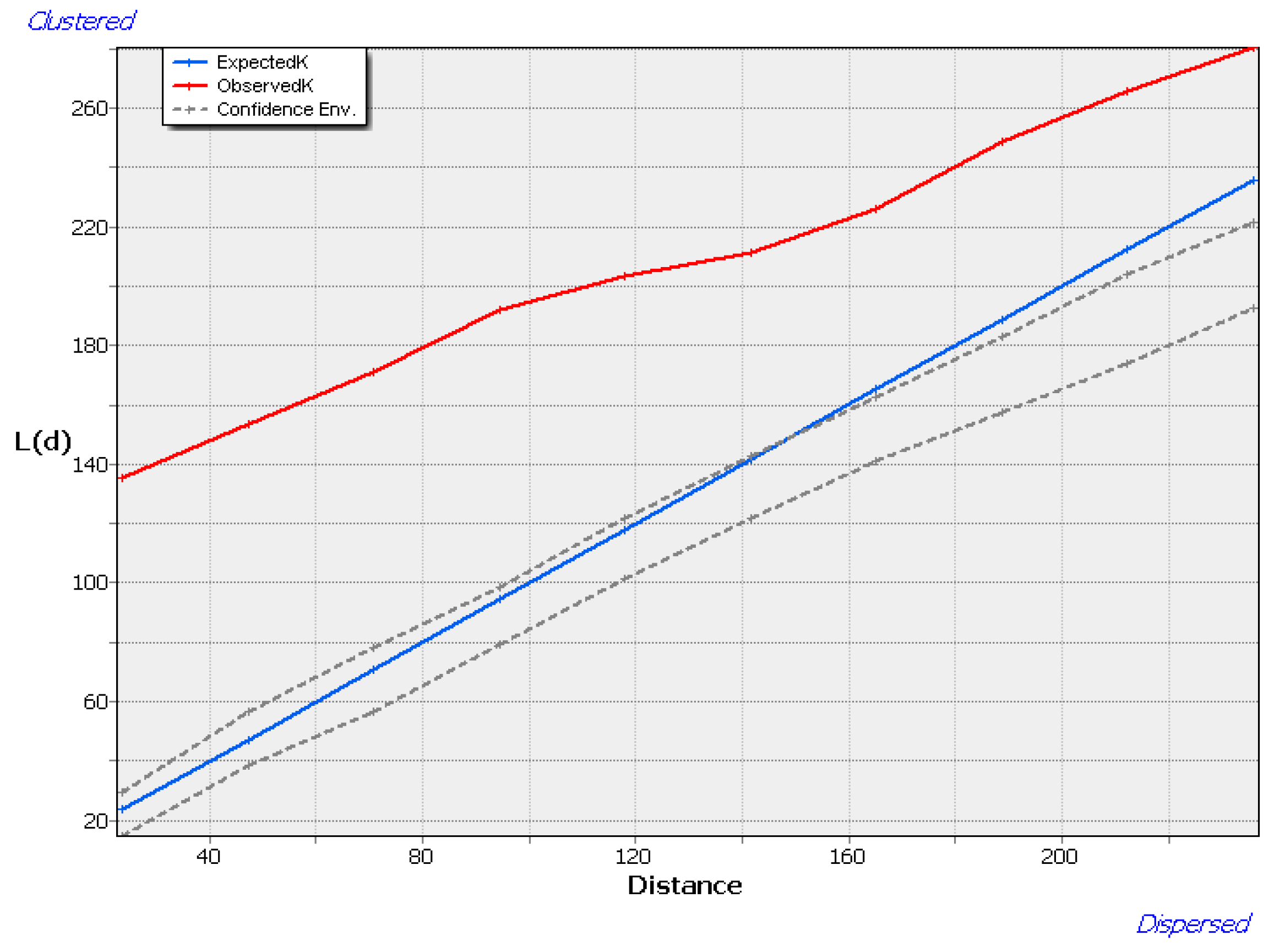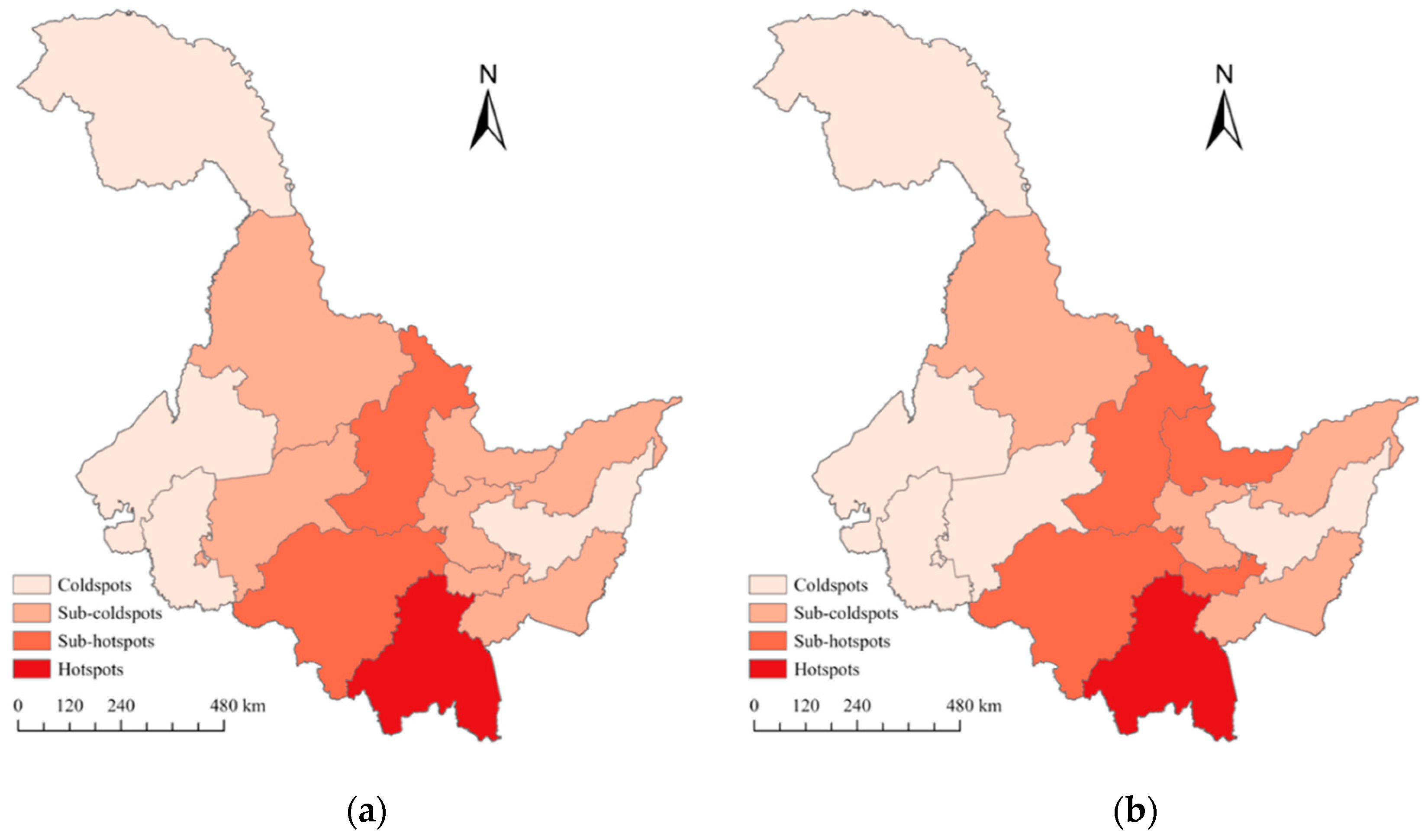Identification and Spatial Correlation of Imported Timber Landing Processing Industrial Clusters in Heilongjiang Province of China
Abstract
1. Introduction
2. Materials and Methods
2.1. Identification of Industrial Clusters
2.2. Spatial Pattern and Correlation Analysis
2.2.1. Multi-Distance Spatial Clustering Analysis
2.2.2. Hotspot Analysis
2.2.3. Spatial Autocorrelation Analysis
2.3. Data Investigation
3. Results
3.1. Status of Imported Timber Landing Processing Industry in Heilongjiang Province
3.1.1. Results of Imported Timber Landing Processing Rate in Heilongjiang Province
3.1.2. Location Quotient of Imported Timber Landing Processing Industry in Heilongjiang Province
3.2. Spatial Analysis of Imported Timber Landing Processing Enterprises in Heilongjiang Province
3.2.1. Spatial Distribution of Timber Landing Processing Enterprises
3.2.2. Spatial Clustering Analysis on Imported Timber Landing Processing Enterprises
3.2.3. Hotspot Analysis on Imported Timber Landing Processing Enterprises
3.2.4. Spatial Autocorrelation on the Imported Timber Landing Processing Enterprises
4. Discussions
4.1. Comparison of Imported Timber Landing Processing Status in Heilongjiang Province
4.2. Spatial Characteristics of Timber Landing Processing Industrial Clusters in Heilongjiang Province
4.3. Policy Implications
4.4. Limitations and Future Research
5. Conclusions
Author Contributions
Funding
Institutional Review Board Statement
Informed Consent Statement
Data Availability Statement
Acknowledgments
Conflicts of Interest
References
- Zhang, H.; Zhao, Q.; Kuuluvainen, J.; Wang, C.; Li, S. Determinants of China’s lumber import: A bounds test for cointegration with monthly data. J. For. Econ. 2015, 21, 269–282. [Google Scholar] [CrossRef]
- Liu, N.W.; Cao, C.K.; Yu, X.X. China’s import and export trade of wood and wood products in 2020 and its outlook in 2021. China For. Prod. Ind. 2021, 58, 65–68. [Google Scholar]
- Jiang, Y.H.; Chen, Y.; Jiang, H.F. Trend and volatility of China’s timber imports. World For. Res. 2021, 34, 56–61. [Google Scholar]
- Han, B. Analysis on China timber imports trend. Constr. Sci. Technol. 2021, 20, 17–21. [Google Scholar]
- National Bureau of Statistics of China. Chinese Statistical Yearbook-2001; China Statistical Publishing House: Beijing, China, 2001.
- Roman, K. The Research on Russian Timber Export Trade to China. Master’s Thesis, Soochow University, Suzhou, China, 2021. [Google Scholar]
- Cheng, B.D. Current status, problem and countermeasures of timber import trade of Heilongjiang Province. For. Sci. Technol. 2009, 34, 60–63. [Google Scholar]
- Heilongjiang Bureau of Statistics. Heilongjiang Statistical Yearbook-2021; China Statistical Publishing House: Beijing, China, 2021.
- Xu, H.Z.; Wang, D.M.; Zhang, C. Analysis of pest epidemic situation of Russian timber imports through Heilongjiang Province. For. Sci. Technol. 2018, 43, 48–51. [Google Scholar]
- General Administration of Customs of the People’s Republic of China. China Customs Import and Export Data. Available online: Stats.customs.gov.cn (accessed on 20 October 2022).
- Liu, C. The Study on Sustainable Development of Timber Import Trade between Heilongjiang Province and Russia. Master’s Thesis, Northeast Forestry University, Harbin, China, 2010. [Google Scholar]
- An, C.S. Study on the competitiveness of enterprises trading with Russia in Heilongjiang Province. Stat. Consult. 2014, 3, 28–30. [Google Scholar]
- Li, X.L.; Liu, Z.G.; Tan, S. Evolution of spatial organization pattern of economic cooperation between Heilongjiang of China and Far East of Russia. Acta Geogr. Sin. 2022, 77, 2083–2096. [Google Scholar]
- Wu, R. Research on the imported Russian timber landing processing in Heilongjiang province. Sib. Stud. 2014, 41, 40–43. [Google Scholar]
- Zhang, D.M.; Xie, J.M. Literature review on industrial cluster. Contemp. Econ. 2017, 18, 140–141. [Google Scholar]
- Rosenfeld, S.A. Bringing business clusters into the mainstream of economic development. Eur. Plan. Stud. 1997, 5, 3–23. [Google Scholar] [CrossRef]
- Czamanski, S.; Ablas, L.A.d.Q. Identification of industrial clusters and complexes: A comparison of methods and findings. Urban Stud. 1979, 16, 61–80. [Google Scholar] [CrossRef]
- Lv, Y.W.; Sun, H. Research on identification of industrial cluster in Xinjiang based on the maximizing deviation and cluster analysis method. Sci. Technol. Manag. Res. 2012, 24, 174–178+183. [Google Scholar]
- Carroll, M.C.; Reid, N.; Smith, B.W. Location quotients versus spatial autocorrelation in identifying potential cluster regions. Annu. Reg. Sci. 2008, 42, 449–463. [Google Scholar] [CrossRef]
- Chen, L.F.; Yan, L. Identification of industrial clusters of oil and gas in China based on composite location quotient. China Popul. Resour. Environ. 2012, 22, 152–157. [Google Scholar]
- Titze, M.; Brachert, M.; Kubis, A. The identification of regional industrial clusters using qualitative input-output analysis (QIOA). Reg. Stud. 2011, 45, 89–102. [Google Scholar] [CrossRef]
- Cho, C. The identification of industrial clusters in the Chungbuk region in Korea. World Technopolis Rev. 2017, 6, 130–147. [Google Scholar]
- Arif, M.; Purnomo, D. Measuring spatial cluster for leading industries in Surakarta with Exploratory Spatial Data Analysis (ESDA). J. Ekon. Pembang. 2017, 18, 64–81. [Google Scholar] [CrossRef]
- Sun, D.Z.; Pang, B.; Yan, H.C. Analysis on advantage of imported wood landing process industry cluster in Inner Mongolia port area. China For. Prod. Ind. 2017, 44, 3–6. [Google Scholar]
- Yan, H.C. Analysis on dynamic mechanism of timber processing industry cluster’s development of border port city. China For. Prod. Ind. 2016, 43, 11–14. [Google Scholar]
- Pang, B. Analysis on the competitiveness advantages of timber processing industrial cluster in Manchuria based on diamond theory model. Mod. SOE Res. 2019, 10, 130–131. [Google Scholar]
- Pang, B.; Sun, D.Z. Development status and problem analysis of the industry cluster in Inner Mongolia port. J. Inn. Mong. Univ. Financ. Econ. 2016, 14, 37–40. [Google Scholar]
- Haggett, P. Locational Analysis in Human Geography; Edward Arnold: London, UK, 1965. [Google Scholar]
- Moral, S.S. Industrial clusters and new firm creation in the manufacturing sector of Madrid’s metropolitan region. Reg. Stud. 2009, 43, 949–965. [Google Scholar] [CrossRef]
- Morar, S. Geographical specialization in Spanish agriculture before and after integration in the European Union. Reg. Sci. Urban Econ. 2004, 34, 309–320. [Google Scholar] [CrossRef]
- Li, H.Y. Research on Industrial Spatial Layout of Dashiqiao Based on ESDA; Shenyang Jianzhu University: Shenyang, China, 2019. [Google Scholar]
- Pominova, M.; Gabe, T.; Crawley, A. The stability of location quotients. Rev. Reg. Stud. 2022, 52, 296–320. [Google Scholar] [CrossRef]
- Wang, T.T.; Chen, G.X.; Yuan, F. Spatial-temporal aggregation characteristics and indication of metallogenic cores of Magmatite in the middle and lower reaches of the Yangtze River based on GIS. Geogr. Geo-Inf. Sci. 2020, 36, 19–25. [Google Scholar]
- She, B.; Zhu, X.Y. Spatial distribution and evolution of city management events based on the spatial point pattern analysis: A case study of Jianghan District, Wuhan City. Prog. Geogr. 2013, 32, 924–931. [Google Scholar]
- Kosfeld, R.; Eckey, H.F.; Lauridsen, J. Spatial point pattern analysis and industry concentration. Ann. Reg. Sci. 2011, 47, 311–328. [Google Scholar] [CrossRef]
- Xu, S.H. Hotspot analysis on the domestic tourist source market in Wuhan. J. Hubei Univ. Arts Sci. 2020, 41, 51–57. [Google Scholar]
- Galia, T.; Tichavský, R.; Wyżga, B.; Mikuś, P.; Zawiejska, J. Assessing patterns of spatial distribution of large wood in semi-natural, single-thread channels of Central Europe. Catena 2022, 215, 106315. [Google Scholar] [CrossRef]
- Getis, A.; Ord, J. The analysis of spatial association by use of distance statistic. Geogr. Anal. 1992, 24, 189–206. [Google Scholar] [CrossRef]
- Yu, W.H.; Ai, T.H.; Yang, M.; Liu, J.P. Detecting “Hot Spots” of facility POIs based on kernel density estimation and spatial autocorrelation technique. Geomat. Inf. Sci. Wuhan Univ. 2016, 41, 221–227. [Google Scholar]
- Mitchell, L.; Frank, M.R.; Harris, K.D.; Dodds, P.S.; Danforth, C.M. The geography of happiness: Connecting Twitter sentiment and expression, demographics, and objective characteristics of place. PLoS ONE 2013, 8, e64417. [Google Scholar] [CrossRef]
- Zhu, Y.L.; Jing, C.F.; Fu, J.Y. Analysis of space-time pattern of robbery crime based on space-time cube. Sci. Surv. Mapp. 2019, 44, 132–138+145. [Google Scholar]
- Wang, Z.L.; Liu, X.J.; Lu, J. Construction and spatial-temporal analysis of crime network: A case study on Burglary. Geomat. Inf. Sci. Wuhan Univ. 2018, 43, 759–765. [Google Scholar]
- Zhang, F.; Song, X.N.; Dong, H.Z. Analysis of the green competitiveness index of manufacturing industry and its evolution characteristics of time and space pattern in Guangdong-Hong Kong-Macao greater bay area. China Soft Sci. 2019, 10, 70–89. [Google Scholar]
- García-Palomares, J.C.; Gutiérrez, J.; Mínguez, C. Identification of tourist hot spots based on social networks: A comparative analysis of European metropolises using photo-sharing services and GIS. Appl. Geogr. 2015, 63, 408–417. [Google Scholar] [CrossRef]
- Shan, B.Y.; Zhang, Z.X.; Chen, Y.Q. Analysis methods of spatio-temporal patterns and its empirical applications —A case of study of manufacturing industry of Shandong Province. J. Geomat. Sci. Technol. 2021, 38, 624–630+638. [Google Scholar]
- Chen, Z.L.; Wu, J.Z. Evolution of logistics industry carbon emissions in Heilongjiang Province, China. Sustainability 2022, 14, 9758. [Google Scholar] [CrossRef]
- Wu, J.; Yang, A.T. Empirical analysis of economic spatial structure of Beijing-Tianjin-Hebei region based on ESDA and CSDA. China Soft Sci. 2010, 3, 111–119. [Google Scholar]
- Ord, J.K.; Getis, A. Local spatial autocorrelation statistics: Distributional issues and an application. Geogr. Anal. 1995, 27, 286–306. [Google Scholar] [CrossRef]
- Zhou, X.F. Study on Spatial and Temporal Evolution of Regional Economic Differences between Northeast Provincial Border-Regions Based on ESDA-GIS; Northeast Normal University: Changchun, China, 2019. [Google Scholar]
- Anselin, L. Local indicators of spatial association-LISA. Geogr. Anal. 1995, 27, 93–115. [Google Scholar] [CrossRef]
- Wu, D.L.; He, W.; Li, Z. Spatial-temporal difference and influencing factors of cultivated land Use efficiency of Sichuan Province based on DEA-ESDA. J. Sichuan Norm. Univ. 2020, 43, 270–276. [Google Scholar]
- Silva, G.S.; Amarante, P.A.; Amarante, J.C.A. Agricultural clusters and poverty in municipalities in the Northeast Region of Brazil: A spatial perspective. J. Rural Stud. 2022, 92, 189–205. [Google Scholar] [CrossRef]
- Yang, Y.Y. Analysis on the characteristics and problems of border trade processing industry cluster in Guangxi Border Port. J. Cust. Trade 2021, 42, 112–121. [Google Scholar]
- Zhao, M.X. Study on the Impacts of Ending Entirety Deforestation on Wood Processing Industry of Heilongjiang Province; Northeast Forestry University: Harbin, China, 2017. [Google Scholar]
- Wu, J.Z.; Wang, H.; Liu, B.F. Influencing factors for the import of wooden forest products in Heilongjiang Province. J. Northeast For. Univ. 2021, 49, 95–99. [Google Scholar]
- Northeast Network. Summary of the Business Work in Heilongjiang Province during the 13th Five-Year Plan. Available online: https://baijiahao.baidu.com/s?id=168483243472921060&wfr=spider&for=pc (accessed on 10 October 2022).
- Li, H.J.; Cheng, B.D.; Yang, J. The influence of epidemic situation on the layout of global value chain of timber industry. J. Agrotech. Econ. 2022, in press. [Google Scholar]
- Jia, Q.W. Study on Timber Industry Development in Mudanjiang City; Jilin University: Changchun, China, 2014. [Google Scholar]




| City | No. of Timber Processing Enterprises | No. of Surveyed Enterprises | Survey Percentage (%) | Landing Processing Volume (1000 m3) |
|---|---|---|---|---|
| Harbin | 158 | 49 | 31 | 58.86 |
| Suihua | 18 | 5 | 27.78 | 2.38 |
| Qiqihar | 9 | 1 | 11.12 | 0.50 |
| Jiamusi | 34 | 10 | 29.41 | 33.23 |
| Mudanjiang | 331 | 126 | 38.06 | 535.38 |
| Heihe | 9 | 3 | 33.33 | 27.52 |
| Jixi | 12 | 8 | 66.67 | 17.04 |
| Hegang | 10 | 3 | 30 | 40.50 |
| Qitaihe | 5 | 3 | 60 | 59.56 |
| Shuangyashan | 4 | 1 | 25 | 0.00 |
| Daqing | 3 | 0 | 0 | - |
| Daxing’anling | 21 | 6 | 28.57 | - |
| Yichun | 75 | 28 | 37.33 | 42.54 |
| Total | 689 | 243 | 35.27% | 817.51 |
| City | Prefecture-Level Cities | Heilongjiang Province | LQ | ||||
|---|---|---|---|---|---|---|---|
| Average Timber Landing Processing Value | Average Total Import Value | Percentage (%) | Average Timber Landing Processing Value | Average Total Import Value | Percentage (%) | ||
| Harbin | 1.72 | 125.35 | 1.37 | 21.70 | 1346.3 | 1.61 | 0.85 |
| Mudanjiang | 13.27 | 218.98 | 6.06 | 21.70 | 1346.3 | 1.61 | 3.76 |
| Jiamusi | 1.05 | 37.78 | 2.77 | 21.70 | 1346.3 | 1.61 | 1.72 |
| Yichun | 1.06 | 4.19 | 25.39 | 21.70 | 1346.3 | 1.61 | 15.75 |
| Heihe | 0.76 | 33.04 | 2.30 | 21.70 | 1346.3 | 1.61 | 1.43 |
| Hegang | 1.22 | 20.19 | 6.02 | 21.70 | 1346.3 | 1.61 | 3.74 |
| Cluster Category | Region | Development Trends |
|---|---|---|
| H–H | Mudanjiang | Attract surrounding industries to gather |
| H–L | Harbin | High level of self-development, but negatively correlated with surrounding |
| L–H | Shuangyashan, Suihua, Jiamusi, Daqing | Low level of development, but has potential for development |
| L–L | Hegang, Qitaihe, Qiqihar, Yichun, Jixi, Heihe | Low level of self and surrounding development |
Disclaimer/Publisher’s Note: The statements, opinions and data contained in all publications are solely those of the individual author(s) and contributor(s) and not of MDPI and/or the editor(s). MDPI and/or the editor(s) disclaim responsibility for any injury to people or property resulting from any ideas, methods, instructions or products referred to in the content. |
© 2023 by the authors. Licensee MDPI, Basel, Switzerland. This article is an open access article distributed under the terms and conditions of the Creative Commons Attribution (CC BY) license (https://creativecommons.org/licenses/by/4.0/).
Share and Cite
Zhou, B.; Qi, X.; Hou, X.; Chen, Z.; Wu, J. Identification and Spatial Correlation of Imported Timber Landing Processing Industrial Clusters in Heilongjiang Province of China. Sustainability 2023, 15, 5061. https://doi.org/10.3390/su15065061
Zhou B, Qi X, Hou X, Chen Z, Wu J. Identification and Spatial Correlation of Imported Timber Landing Processing Industrial Clusters in Heilongjiang Province of China. Sustainability. 2023; 15(6):5061. https://doi.org/10.3390/su15065061
Chicago/Turabian StyleZhou, Baixu, Xinyue Qi, Xinru Hou, Zhili Chen, and Jinzhuo Wu. 2023. "Identification and Spatial Correlation of Imported Timber Landing Processing Industrial Clusters in Heilongjiang Province of China" Sustainability 15, no. 6: 5061. https://doi.org/10.3390/su15065061
APA StyleZhou, B., Qi, X., Hou, X., Chen, Z., & Wu, J. (2023). Identification and Spatial Correlation of Imported Timber Landing Processing Industrial Clusters in Heilongjiang Province of China. Sustainability, 15(6), 5061. https://doi.org/10.3390/su15065061






